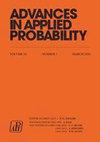Bootstrap percolation in random geometric graphs
IF 1.2
4区 数学
Q3 STATISTICS & PROBABILITY
引用次数: 0
Abstract
Following Bradonjić and Saniee, we study a model of bootstrap percolation on the Gilbert random geometric graph on the 2-dimensional torus. In this model, the expected number of vertices of the graph is n, and the expected degree of a vertex is $a\log n$ for some fixed $a>1$ . Each vertex is added with probability p to a set $A_0$ of initially infected vertices. Vertices subsequently become infected if they have at least $ \theta a \log n $ infected neighbours. Here $p, \theta \in [0,1]$ are taken to be fixed constants. We show that if $\theta < (1+p)/2$ , then a sufficiently large local outbreak leads with high probability to the infection spreading globally, with all but o(n) vertices eventually becoming infected. On the other hand, for $ \theta > (1+p)/2$ , even if one adversarially infects every vertex inside a ball of radius $O(\sqrt{\log n} )$ , with high probability the infection will spread to only o(n) vertices beyond those that were initially infected. In addition we give some bounds on the $(a, p, \theta)$ regions ensuring the emergence of large local outbreaks or the existence of islands of vertices that never become infected. We also give a complete picture of the (surprisingly complex) behaviour of the analogous 1-dimensional bootstrap percolation model on the circle. Finally we raise a number of problems, and in particular make a conjecture on an ‘almost no percolation or almost full percolation’ dichotomy which may be of independent interest.随机几何图中的自举渗流
继bradonjiki和Saniee之后,我们研究了二维环面上Gilbert随机几何图上的自举渗流模型。在该模型中,对于某个固定的$a>1$,图的期望顶点数为n,顶点的期望度数为$a\log n$。每个顶点以p的概率添加到初始感染顶点的集合$A_0$中。如果顶点至少有$ \theta a \log n $被感染的邻居,那么它们随后就会被感染。这里$p, \theta \in [0,1]$被认为是固定常数。我们表明,如果$\theta < (1+p)/2$,那么一个足够大的局部爆发很可能导致感染蔓延到全球,除了o(n)个顶点外,所有顶点最终都被感染。另一方面,对于$ \theta > (1+p)/2$,即使一个人对抗性地感染了半径为$O(\sqrt{\log n} )$的球内的每个顶点,感染很可能只会传播到最初被感染的顶点以外的o(n)个顶点。此外,我们给出了$(a, p, \theta)$区域的一些边界,以确保出现大规模的局部爆发或存在从未被感染的顶点岛。我们还给出了圆上类似的一维自举渗透模型(令人惊讶的复杂)行为的完整图像。最后,我们提出了一些问题,特别是对“几乎没有渗透或几乎完全渗透”的二分法提出了一个猜想,这可能是一个独立的兴趣。
本文章由计算机程序翻译,如有差异,请以英文原文为准。
求助全文
约1分钟内获得全文
求助全文
来源期刊

Advances in Applied Probability
数学-统计学与概率论
CiteScore
2.00
自引率
0.00%
发文量
64
审稿时长
6-12 weeks
期刊介绍:
The Advances in Applied Probability has been published by the Applied Probability Trust for over four decades, and is a companion publication to the Journal of Applied Probability. It contains mathematical and scientific papers of interest to applied probabilists, with emphasis on applications in a broad spectrum of disciplines, including the biosciences, operations research, telecommunications, computer science, engineering, epidemiology, financial mathematics, the physical and social sciences, and any field where stochastic modeling is used.
A submission to Applied Probability represents a submission that may, at the Editor-in-Chief’s discretion, appear in either the Journal of Applied Probability or the Advances in Applied Probability. Typically, shorter papers appear in the Journal, with longer contributions appearing in the Advances.
 求助内容:
求助内容: 应助结果提醒方式:
应助结果提醒方式:


